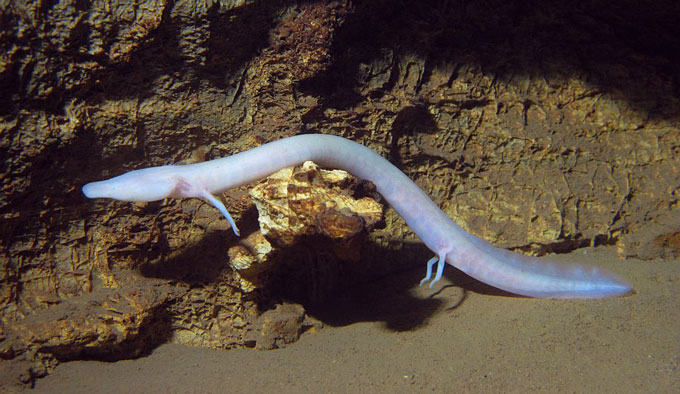Once upon a time, olms knew the cool drizzle of rain and bathed in the glow of the sun. But millions of years ago, these aquatic salamanders moved to underwater caves beneath southeastern Europe’s Dinaric Alps and evolved into the pale, blind, foot-long creatures known today (SN: 4/20/16).
Now,
a study reveals one trait that may help olms inhabit these caverns that have
little food: The salamanders don’t seem to move
much.
One olm even appeared to haunt roughly the same spot for seven years within a limestone
cave in eastern Bosnia-Herzegovina, researchers report online January 28 in the
Journal of Zoology.
The
pitch-black cave was seemingly full of the creatures when zoologist Gergely
Balázs of Eötvös Loránd University in Budapest and his colleagues began searching for olms
(Proteus anguinus) about 10 years ago. After repeated dives in the cave,
the researchers began to suspect that they were seeing the same olms in the
same spots each time.
So
starting in 2010, the team used an injectable liquid marker to tag 26 olms found
in the cave. Using a unique marking pattern for each olm, the researchers could
recognize the salamanders by sight, recording how far each olm moved between sightings
over eight years. In addition to the one extremely sedentary olm, most of the others
didn’t seem to move more than 10 meters from their original spots over several
years, the scientists found.

Olms could be considered extreme couch potatoes. A slow pace of life — punctuated roughly every 12 years by the need to reproduce — helps to conserve energy over a life span that can last for roughly 100 years, the researchers say. Energy conservation is paramount in these caves. With little to go around of the crustaceans and snails that olms eat, the salamanders can go 10 years without eating.
Alternatively,
the olms might have wandered all over the cave but returned to rest on the same
spot in time for the researchers’ next visit — a scenario Balázs thinks is less
probable.
“They
are really good swimmers,” Balázs notes. So the eel-like olms could “move
around and try different spots to see if the neighbor is nicer, or there’s more
prey … or whatever. And they just don’t do it.”
Other
amphibians that tend to stick to one location typically depend on exceptionally
unique microhabitats — such as the water-filled leaves of a single bromeliad
plant, or beneath a specific stone. Olms live in a place where suitable habitat
is spread throughout long, winding cave systems, within which the density of
prey is more or less steady. There’s not very much food, but it’s evenly
distributed, Balázs says. So there may be no real benefit to moving in an
environment where the chances of snatching up small crustaceans or snails are
the same everywhere, he says.
Cave biologist Matthew Niemiller of the University of Alabama in Huntsville agrees. “If you’re a salamander trying to survive in this … food-poor environment and you find a nice area to establish a home or territory — why would you leave?”
